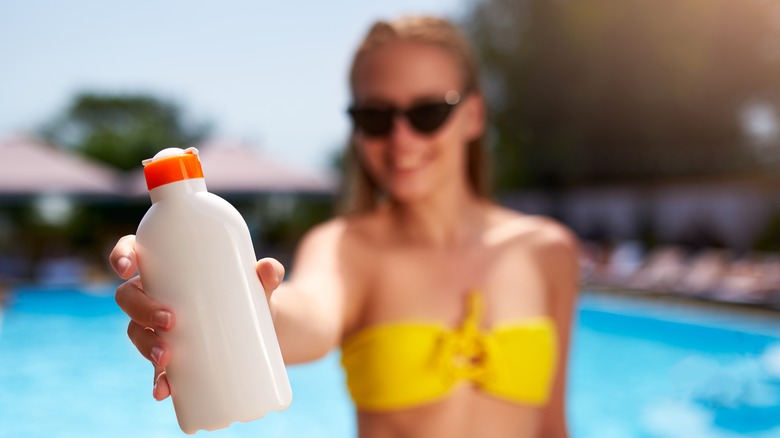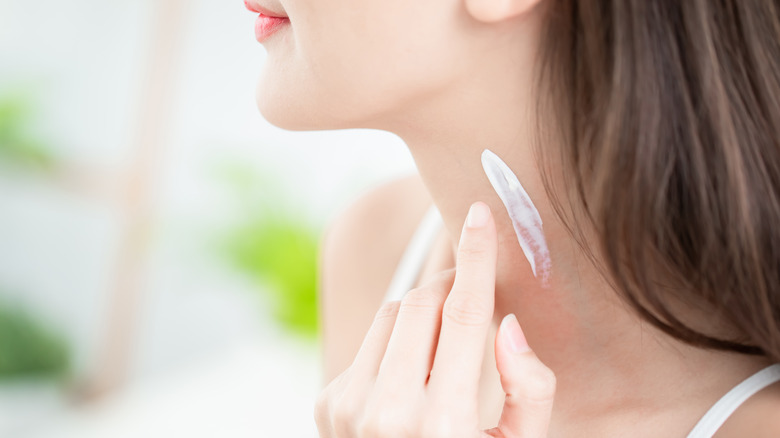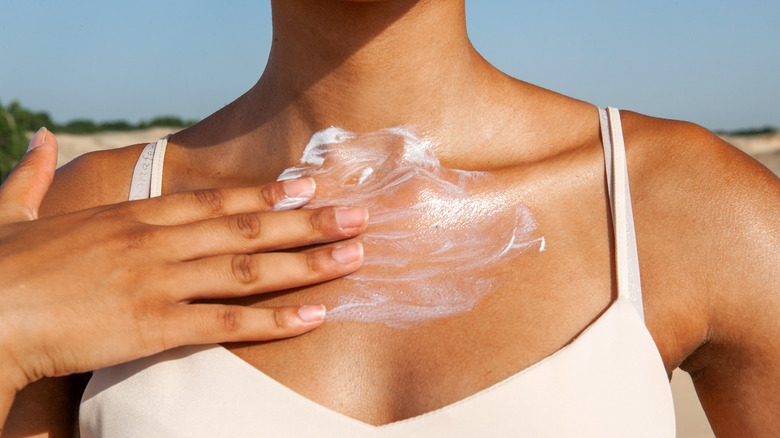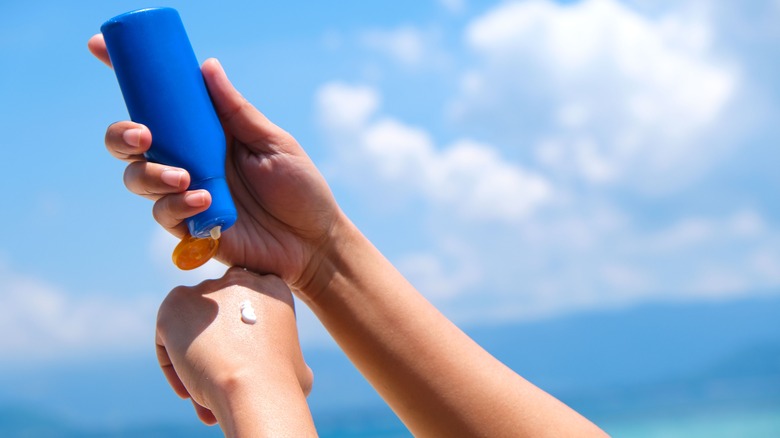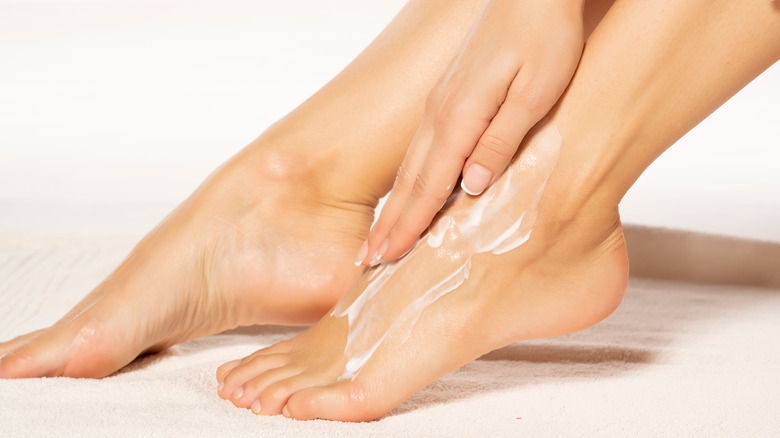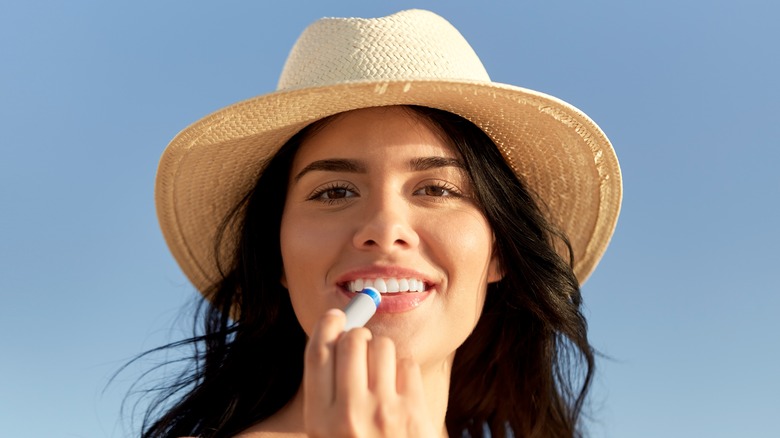The Most Important Places To Use Both SPF And Moisturizer That You're Probably Missing
We may receive a commission on purchases made from links.
Most of us are aware that rain or shine, wearing sunscreen 365 days a year is essential. Still, most people who skip sunscreen do so because they don't like the chalky appearance or smell of some formulas, or they simply forget. And while the sun gives us life, too much of a good thing can cause irreversible skin damage such as fine lines and uneven skin tone, which are forms of premature aging.
New York City-based dermatologist Michele Green tells Byrdie, "The UV rays can penetrate the skin even in the deepest layers and cause changes to DNA at the cellular level." In this case, skin cancer would be the most severe form of sun damage. Dr. Green added that sometimes it could take years to notice signs of sun damage because it depends on how deeply the UV rays have affected the skin.
Many who diligently use sunscreen or moisturizers only wear it on their faces. A study published in the Journal of the American Academy of Dermatology found that only 43% of women "regularly use sunscreen on their face," while only 34% use it to protect all exposed skin.
This could be why people notice signs of aging in parts other than their faces because they mostly get ignored. Next time, show a little love with SPF and moisturizer on these important places, as every inch of your skin is prone to signs of aging.
Neck
Most have a multistep skincare routine for the skin on their faces, but we often forget the skin on our necks. How many of us use a cleanser on our necks every time we wash our faces?
According to plastic surgeon Ryan Neinstein of NYC Surgical Associates, the main reason we notice premature signs of aging on the neck is gravity, besides not giving it the same TLC as your face. Dr. Neinstein told Prevention, "The second reason is sun exposure, as we frequently tend to under-treat our neck area when applying sunscreen." The UV rays break down collagen on the skin of the neck resulting in wrinkles, crepey skin, and sagging. Don't neglect your neck when applying sunscreen and make sure to reapply if you're outdoors for longer.
Products like StriVectin's TL Advanced Tightening Neck Cream are moisturizers for the neck that help diminish the appearance of horizontal lines and visibly lift the skin, if you're struggling with sagging.
Décolletage
The décolletage is another part of your body that doesn't get the same love and protection as your face. While some might moisturize and use SPF on their face and neck, the décolletage and chest often remain neglected while sustaining sun damage.
Dr. Elizabeth Houshmand, a board-certified dermatologist based in Dallas, told Skincare.com, "The skin on your décolletage produces less oil than the skin on your face, making it more delicate and prone to damage. It also receives a high amount of sun exposure and is, therefore, one of the first areas on the body to show the premature signs of aging." Dr. Houshmand recommends using a moisturizer and SPF on your face and extending it to your neck, chest, and décolletage. Hence, every exposed part of your body gets hydration and sun protection.
You don't necessarily need a different product for different parts of your body, so try RoC Multi Correxion 5 in 1 Chest, Neck, and Face Moisturizer Cream with SPF 30 because this cream is gentle enough to use for the delicate skin on your face, neck, and chest. Plus, it has broad spectrum protection against premature signs of aging and burning. This multitasker is quite affordable and has over 4,000 reviews on Amazon. At night, it might not be a bad idea to apply retinol to the area as well.
Hands
We wash our hands more than any other body part, and many neglect using a hand cream after every wash. The back of our hands also sustain a substantial amount of sun exposure; yet, we often don't moisturize our hands and protect them with SPF afterward.
According to board-certified dermatologist Kally Papantoniou, our hands can be among the first body parts to show signs of aging, especially for women (via The Healthy). Dr. Papantoniou told The Healthy, "Hormonal changes result in a loss of skin elasticity and volume loss on the backs of our hands," and added that these changes could contribute to fine lines and crepey skin.
Perhaps, keep a hand cream with SPF by the sink or in your purse when you're out, so they aren't left dry and unprotected. Deborah Lippmann Rich Girl Hand Cream SPF 25 is an option that's infused with shea butter and avocado to deeply hydrate your hands without the sticky feeling (and it smells great). With an impressive 4.5 out of 5 stars on Amazon, one reviewer said, "Best hand cream out there. I'm very vain about my hands. I'm 50 and my hands are wrinkle and spot free."
Feet
While many are pretty good about moisturizing their feet in the winter months, they're mostly neglected in warmer weather. That's when the top of your feet get the most sun exposure as you're running around in sandals or bare feet at the beach or by the pool. Like the back of your hands, the skin on the top of your feet can also get thin with age.
Rajani Katta, M.D., board-certified dermatologist, told Healthline, "If you're wearing sandals, the rule is sunblock first, sandals second." Choose a waterproof sunscreen if you're playing in the water and if you want a mess-free application, just spray it on the top of your feet while applying it to other exposed parts of the body.
The skin on your feet can also get dry; if left untreated, you can get painful cracked heels. Keeping your feet hydrated is key to maintaining feet health, plus your feet carry you everywhere, so you need to show them some love. "Foot conditions can include thickened heels, calluses, dry cracked heels, and more," Dr. Muneeb Shah told Byrdie.
Invest in a foot cream like AmLactin Foot Repair Foot Cream Therapy, a salve for dry feet with 15% lactic acid for gentle exfoliation.
Lips
The market is saturated with products to make lips look more luscious and full, and while most of us use lip balms to keep our lips hydrated — we forget that lips need sun protection too. The thin skin on the lips is (almost) always exposed to UV rays with zero protection. The Skin Cancer Foundation states that UV rays are the number one cause of lip cancer.
Los Angeles-based board-certified dermatologist Michael Kassardjian told Healthline, "Unfortunately, we do see quite a bit of skin cancers on the lip, and these skin cancers can become more aggressive [and] require surgical treatment, so prevention is key." That sounds scary, and thankfully there are plenty of SPF-infused lip balms on the market that can help keep your lips moisturized and protected in one step.
Sun Bum Sunscreen Lip Balm SPF 30 keeps your lips safe from the sun and has aloe and vitamin E for hydration. It's affordable and available in seven flavors. If you're looking for a bit of color along with hydration and sun protection you can't go wrong with Coola Organic Mineral Sunscreen Lip Balm SPF 30. This antioxidant-rich lip balm deeply nourishes your lips and leaves a hint of flattering color, whether you want something pink, coral, or red.
